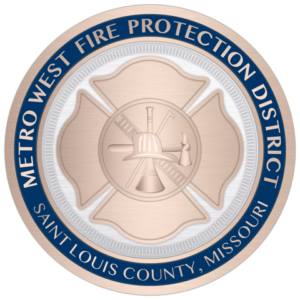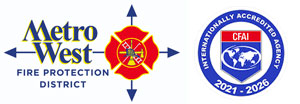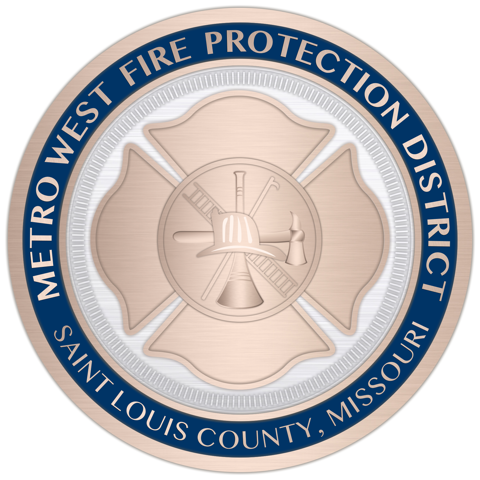Metro West Challenge Coin
Metro West
Challenge Coin
The Metro West challenge coin was designed to represent the uniqueness and drive of the organization. The front of the coin presents the storied history of both Metro West and the fire service while the Art Deco compass design on the back features the agency’s mission statement and core values. Every word, color and design element were carefully chosen to remind the coin bearer of the responsibility, motivation, and distinctiveness of the Metro West Fire Protection District.
 Metro West Fire Protection District
Metro West Fire Protection District
In 1934, the organization began a tradition of service as the Community Fire Association. The volunteer fire department would be dissolved when citizens voted to form the Ballwin Fire Protection District in 1957. A growing footprint created the need to find a name better fitting of the response area. On April 9, 1993, the name of the organization was changed to the Metro West Fire Protection District, which is represented across the top of the coin’s face.
St. Louis County, Missouri
The denotation of St. Louis County, Missouri represents the Metro West geographical area of service. With jurisdictional boundaries encompassing 57 1/2 square miles in west St. Louis County, Metro West provides service to Ballwin, Chesterfield, Clarkson Valley, Castlewood, Ellisville, Sherman, Wildwood, Winchester, and unincorporated St. Louis County. The meaning also speaks to the regional assets Metro West provides to the greater St. Louis area including the dive team, heavy rescue and tactical paramedics.
Field of Blue
The first known usage of the color blue was around 6,000 years ago when Egyptians began using Lapis, a rare semiprecious stone, to generate blue pigments. Modern usage began in the year 431 AD when the Catholic Church began using liturgical colors to symbolize seasons within the church calendar. Feasts and times associated with Mary were assigned the color blue and is why Mary is often depicted in a blue robe. Because she stood for innocence and trustworthiness, this same shade of blue was adopted by militaries and police agencies to convey a similar essence of trust. The shade of blue would become known as “navy blue” when the Royal Navy of the United Kingdom began incorporating the color into their uniforms in 1748.
The color blue on the coin is derived from the Metro West logo. This field of blue, found on both sides of the coin, stands for trustworthiness – a visual representation of the Metro West core value of trust.
Maltese cross
The prominent image taken from the Metro West logo is of a Maltese cross. This shape was adopted by the early Knights of Malta who designed a strong, yet agile shield to carry while riding horses into battle. The Knights of Malta were largely a charitable, non-military organization during the 11th and 12th centuries, providing aid to the sick and helping establish many hospitals. They would later take up arms and join the Knights of the Crusades to defend the Holy Land.
This new breed of knight wore large crimson-colored capes over a suit of armor. The capes were largely symbolic but found to also serve a practical purpose. As a castle was attacked, defenders would throw containers of naphtha and other flammable liquids down onto the invading force. A torch would then be thrown, igniting the attacker’s fuel-soaked clothing. The Knights of Malta would use their capes to smother the flames on their fellow knights. Thus, they would become synonymous with extinguishing fire.
As a result of their bravery, the Maltese cross would become known as an honorable badge of acclaim. The legend of the cross would grow, and the shape is now associated with the qualities of loyalty, bravery and represents one who defends the weak. The scramble in the center of the cross depicts a grouping of fire service tools including a ground ladder, pike pole, axe, helmet and bugle. Bugles, or speaking trumpets, were large brass devices resembling a megaphone from which orders were given to firefighters on the fire ground. Collectively, the images of these tools symbolize preparedness and the readiness of Metro West to respond to the call of help.
Reeding
In 1792, the Coinage Act established legislation requiring coins to be made of their face value in gold or silver. Soon would-be criminals saw they could make a profit by filing shavings from the sides of gold and silver coins to sell the precious metal. The U.S. Mint then began adding ridges to the coins’ edges in a process known as reeding. This made tampering with the coin obvious and assured the coins true value. The complete, utampered reeding lines encompassing the Maltese cross assures all the full worth of the Metro West Fire Protection District and speaks to our significant value to the community we serve.
 Art Deco Design
Art Deco Design
The reflected M abstract, borrowed from the Metro West logo, is repeated and layered to create an Art Deco design chosen to represent uniqueness and optimism.
Art Deco first came into popularity during the early 1920s and represented a change in popular design thinking. It served as a direct response to the previous Art Nouveau style which focused on ornate, delicate designs. Art Deco’s aesthetics emphasized machine-age streamlining and sleek geometry. This architectural style also flourished during a period of enormous global prosperity. Designs used precious materials as a display of exuberance and energy. The Art Deco style continues to be associated with technology, optimism and prosperity.
The design of this coin stands out from others in the fire service, just as the Metro West Fire Protection District is distinguished from other fire agencies. The rose gold and silver finishes represent this desire to be an industry leader both on a local and national level.
The Art Deco connection to new technology gives a nod to the Metro West core value of quality which vows to adhere to the “highest operational standards while using the best possible tools to complete the job.” The style also speaks to the optimism we bring to the community. Whether responding to an emergency call or providing community outreach for a less urgent matter, Metro West represents a hopefulness and confidence for a successful outcome.
Metro West Core Values
Vincent Van Gogh is quoted as saying, “Conscience is a man’s compass.” This sentiment is depicted on the back of the coin with the five Metro West core values encircling a navigational compass.
In 2018, the Metro West Fire Protection District conducted a self-assessment to discover what truly drives the organization. Every level of the fire district participated through group exercises and candid discussions. Ultimately, a lot of commonality was found in the beliefs about what matters professionally. These beliefs became the five core values of professionalism, quality, reputation, service, and trust. Metro West defines each of these core values as:
- Professionalism – Pride in who we are and how we do business. Respecting our commitment to the community through training and education.
- Quality – The finest effort, every time. Adhering to the highest operational standards while using the best possible tools to complete the job.
- Reputation – Built by those before us, grown by those with us. Honoring the past by providing exceptional standards of care at all levels of the system.
- Service – Bound by our duty to act. Improving the lives of those we encounter with every interaction.
- Trust – Being committed to all that is entrusted to us. The community’s confidence is the foundation of everything we do.
These core values deliver a better understanding of Metro West and further details their commitment to providing the highest level of service possible. The organization believes it is essential the community knows what motivates them to continually strive to leave people in a better position than when they were found. It is why these five words are prominent on a field of blue.
On a compass, the azimuth ring, or rotating bezel, allows the user to align it with orienting lines on a map in order to calculate a bearing for travel. While a typical ring is etched with 360-degree markings, this coin’s azimuth ring, represented by the blue band, is inscribed with the five core values which serve as an emblematic heading for the organization.
Your Life, Our Mission…
At the center of a compass sits the jewel bearing. Here a metal spindle turns in a jewel-lined pivot hole. Jewel bearings are made from precious gems such as rubies, sapphires and other types of corundum. These materials are among the hardest substances on Earth and are capable of surviving the toughest of environments while being both accurate and reliable.
This critical point on the compass is signified by the Metro West mission statement, “Your Life, Our Mission.” These words reside in a four-sided shape representing the district patch worn on the left sleeve of every Metro West uniform. As simply stated, the organizational mission is to care for the lives of those citizens entrusted to their call of duty. This key element serving as the jewel bearing assures the direction of travel for Metro West to be accurate and true.
Compass
Historians believe the Chinese were the first civilization to develop a magnetic compass to be used for navigation during the 11th century. Western Europeans would soon follow at the end of the 12th century. Compasses were initially used as a backup for when the sun, stars and other navigating landmarks were not visible. As compasses became more reliable, they would cement their place as a critical navigational tool.
While the needle of a compass always points north, the direction of travel is represented in the top position of the circle. This coin’s compass indicates moving to the west, or as represented by the MW, a symbolic course towards Metro West.
With the mission statement assuring the direction of travel is accurate and the five core values providing a solid bearing, Metro West will continue to be guided by these foundations as they move forward into the future.
It is believed the challenge coin dates to ancient Rome. Soldiers who performed well in battle would receive an extra coin along with their daily wage. Coins minted with special indicators from their region of origin were often kept by the solider as a cherished memento and a sign of their worth as a soldier.
Coins gained popularity in the modern era during World War I when an officer had coins minted with his flying squadron’s insignia as a gift to his company. Soon custom minted coins became an identifying symbol of one’s military affiliation.
The challenge associated with the coins began in World War II when US soldiers adapted the local German custom of “pfenning checks.” A pfenning was the lowest denomination in German currency. Local tradition dictated if a pfenning check was called at a local pub anyone who could not produce a pfenning from their pocket had to buy the next round of drinks. If everyone in the pub could produce a pfenning, the individual issuing the challenge would have to buy the round. This custom was amended by service men who would issue their own coin challenge. A soldier would ask those in attendance to present their company coin and those unable to do so would be indebted to the group.
Challenge coins are now being used by numerous agencies in a multitude of fields throughout military, first responder and civic organizations. They are used to show affiliation and are often given as a sign of gratitude and respect.



